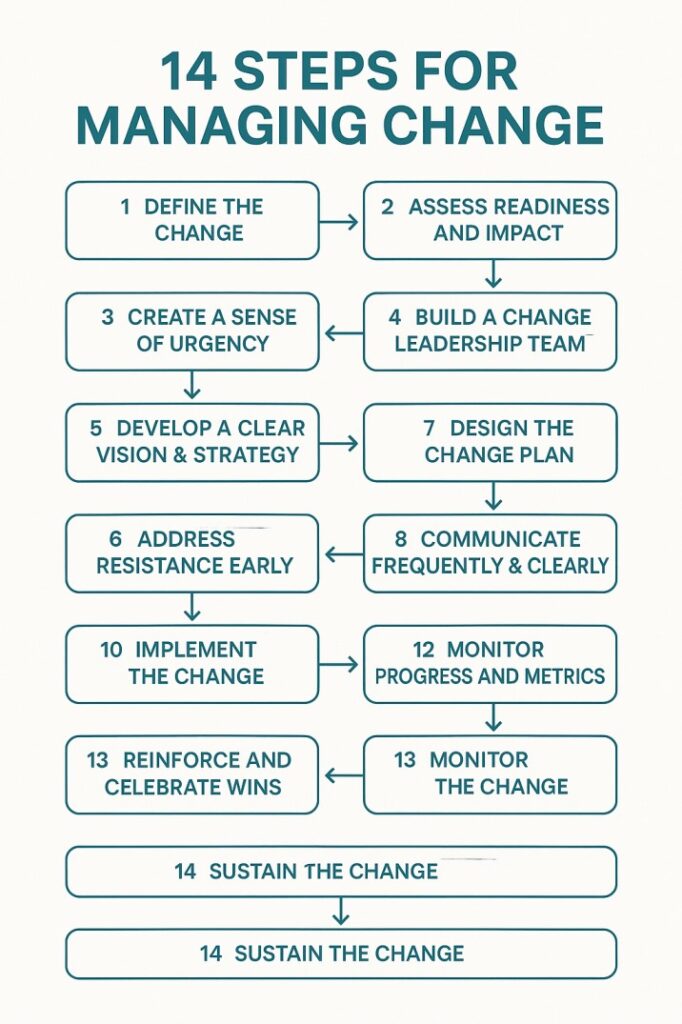Forum breadcrumbs - You are here:PMdistilled ForumExample Category: PMdistilled forumManaging Change
Managing Change
pmdistilled@pmdistilled
84 Posts
Quote from pmdistilled on 21/05/2025, 10:48 AM14 Steps for Managing Change
# Step Description 1 Define the Change Clearly identify what the change is, why it is needed, and what success looks like. 2 Assess Readiness and Impact Evaluate organizational readiness, capacity for change, and who will be affected. Conduct impact and stakeholder analyses. 3 Create a Sense of Urgency Communicate why the change is critical now. Use data, risks, and opportunities to build momentum. 4 Build a Change Leadership Team Form a coalition of sponsors, change agents, and influencers to drive the initiative. 5 Develop a Clear Vision & Strategy Articulate a compelling future state and the roadmap to achieve it. Align it with business goals. 6 Engage Stakeholders Identify stakeholders and involve them early. Understand and address their concerns. 7 Design the Change Plan Prepare a structured change management plan: communication, training, resistance handling, and reinforcement. 8 Communicate Frequently & Clearly Use multiple channels to consistently share updates, benefits, and expectations. Ensure two-way communication. 9 Empower & Equip People Provide resources, training, systems, and authority to support new ways of working. 10 Address Resistance Early Identify root causes of resistance. Use empathy, negotiation, and involvement to manage it constructively. 11 Implement the Change Roll out the change incrementally or fully, depending on the strategy. Monitor adoption and feedback. 12 Monitor Progress and Metrics Use KPIs and feedback to track performance and adaptation. Be ready to pivot. 13 Reinforce and Celebrate Wins Acknowledge progress, reward success, and reinforce behaviors that support the change. 14 Sustain the Change Institutionalize the change through updated policies, processes, leadership behavior, and culture embedding. Grouped into Phases
Phase Steps Included Initiation & Planning 1–5 Engagement & Design 6–9 Execution 10–12 Sustainment 13–14

14 Steps for Managing Change
| # | Step | Description |
|---|---|---|
| 1 | Define the Change | Clearly identify what the change is, why it is needed, and what success looks like. |
| 2 | Assess Readiness and Impact | Evaluate organizational readiness, capacity for change, and who will be affected. Conduct impact and stakeholder analyses. |
| 3 | Create a Sense of Urgency | Communicate why the change is critical now. Use data, risks, and opportunities to build momentum. |
| 4 | Build a Change Leadership Team | Form a coalition of sponsors, change agents, and influencers to drive the initiative. |
| 5 | Develop a Clear Vision & Strategy | Articulate a compelling future state and the roadmap to achieve it. Align it with business goals. |
| 6 | Engage Stakeholders | Identify stakeholders and involve them early. Understand and address their concerns. |
| 7 | Design the Change Plan | Prepare a structured change management plan: communication, training, resistance handling, and reinforcement. |
| 8 | Communicate Frequently & Clearly | Use multiple channels to consistently share updates, benefits, and expectations. Ensure two-way communication. |
| 9 | Empower & Equip People | Provide resources, training, systems, and authority to support new ways of working. |
| 10 | Address Resistance Early | Identify root causes of resistance. Use empathy, negotiation, and involvement to manage it constructively. |
| 11 | Implement the Change | Roll out the change incrementally or fully, depending on the strategy. Monitor adoption and feedback. |
| 12 | Monitor Progress and Metrics | Use KPIs and feedback to track performance and adaptation. Be ready to pivot. |
| 13 | Reinforce and Celebrate Wins | Acknowledge progress, reward success, and reinforce behaviors that support the change. |
| 14 | Sustain the Change | Institutionalize the change through updated policies, processes, leadership behavior, and culture embedding. |
Grouped into Phases
| Phase | Steps Included |
|---|---|
| Initiation & Planning | 1–5 |
| Engagement & Design | 6–9 |
| Execution | 10–12 |
| Sustainment | 13–14 |
Click for thumbs down.0Click for thumbs up.0
